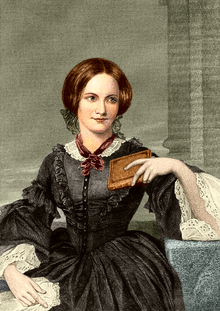This article needs additional citations for verification. (September 2016) |
A first-person narrative (also known as a first-person perspective, voice, point of view, etc.) is a mode of storytelling in which a storyteller recounts events from that storyteller's own personal point of view, using first-person grammar such as "I", "me", "my", and "myself" (also, in plural form, "we", "us", etc.).[1][2] It must be narrated by a first-person character, such as a protagonist (or other focal character), re-teller, witness,[3] or peripheral character.[4][5] Alternatively, in a visual storytelling medium (such as video, television, or film), the first-person perspective is a graphical perspective rendered through a character's visual field, so the camera is "seeing" out of a character's eyes.

A classic example of a first-person protagonist narrator is Charlotte Brontë's Jane Eyre (1847),[1] in which the title character is telling the story in which she herself is also the protagonist:[6] "I could not unlove him now, merely because I found that he had ceased to notice me".[7] Srikanta by Bengali writer Sarat Chandra Chattopadhyay[8] is another first-person perspective novel which is often called a "masterpiece".[9][10][11] Srikanta, the title character and protagonist of the novel, tells his own story: "What memories and thoughts crowd into my mind, as, at the threshold of the afternoon of my wandering life, I sit down to write the story of its morning hours!"[12]
This device allows the audience to see the narrator's mind's eye view of the fictional universe,[13] but it is limited to the narrator's experiences and awareness of the true state of affairs. In some stories, first-person narrators may relay dialogue with other characters or refer to information they heard from the other characters, in order to try to deliver a larger point of view.[6] Other stories may switch the narrator to different characters to introduce a broader perspective. An unreliable narrator is one that has completely lost credibility due to ignorance, poor insight, personal biases, mistakes, dishonesty, etc., which challenges the reader's initial assumptions.[14]
- ^ a b L, L. "Overview: First-person narrative". Oxford Reference. Retrieved 18 June 2017.
- ^ Grammarly, https://www.grammarly.com/blog/first-second-and-third-person/#:~:text=We%2C%20us%2C%20our%2Cand,%2C%20my%2C%20mine%20and%20myself."
- ^ Cite error: The named reference
Ohiowas invoked but never defined (see the help page). - ^ "Literature Glossary - First-person Narration". Shmoop. Retrieved 18 June 2017.
- ^ Stanzel, F.K. (13 March 1986). A Theory of Narrative. CUP Archive. p. 208. ISBN 978-0-521-31063-5.
- ^ a b "Jane Eyre Narrator Point of View". Shmoop. Retrieved 18 June 2017.
- ^ "Examples of Writing in First Person". YourDictionary. Retrieved 18 June 2017.
- ^ Chattopadhyay, Sarat Chandra (2018). Srikanta (in Hindi) (9th ed.). Delhi: Manoj Publications. ISBN 9788181333049.
- ^ Sisir Kumar Das (2006). A History of Indian Literature 1911-1956. Sahitya Academi. p. 340. ISBN 9788172017989.
- ^ George, K. M., ed. (1993). Modern Indian Literature: an Anthology: Fiction. Vol. 2. New Delhi: Sahitya Akademi. pp. 93–94. ISBN 81-7201-506-2.
- ^ Shandilya, Krupa (2017). "Erotic Worship and the Discourse of Rights: Spiritual Feminism in Saratchandra Chatterjee's Fiction". Intimate Relations: Social Reform and the Late Nineteenth-Century South Asian Novel. Evanston: Northwestern University Press. p. 46. ISBN 978-0-8101-3424-9 – via Project MUSE.(subscription required)
- ^ "Srikanta (Part 1)/Chapter 1 - Wikisource, the free online library". en.wikisource.org. Retrieved 2024-07-13.
- ^ Evers, Stuart (13 May 2008). "The dangers of first-person narrative". The Guardian. Retrieved 18 June 2017.
- ^ Wiehardt, Ginny (20 March 2017). "How to Recognize and Create an Unreliable Narrator". The Balance. Retrieved 18 June 2017.